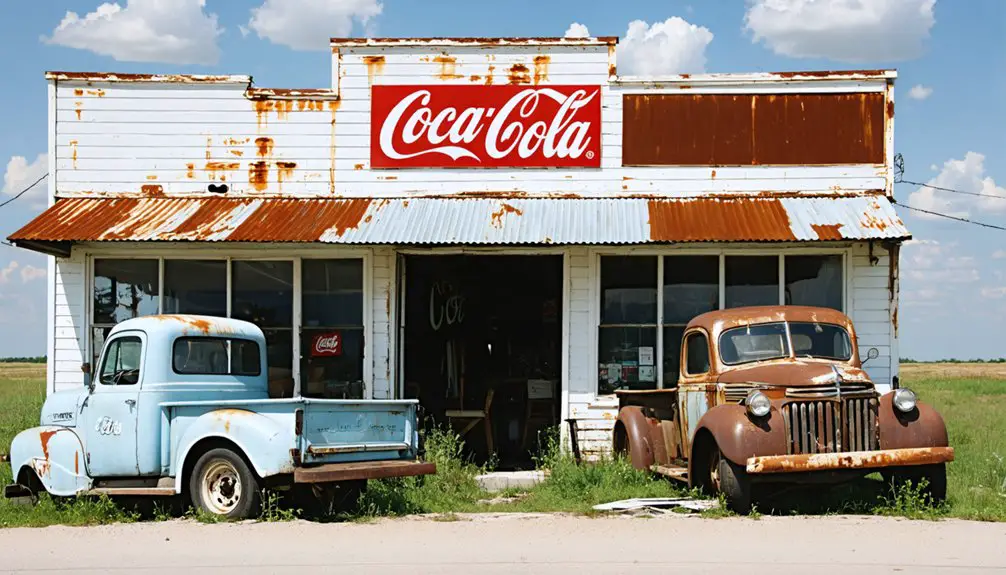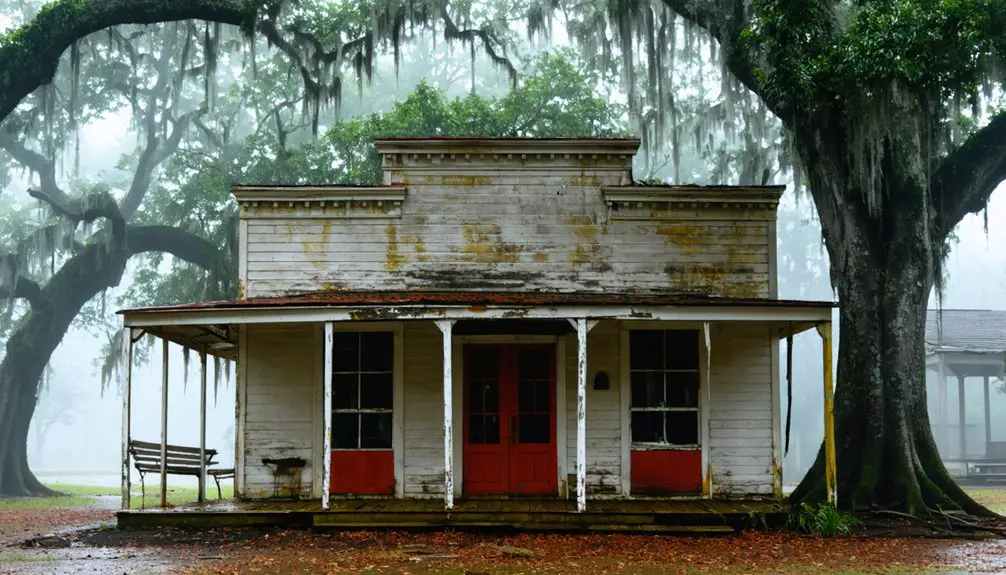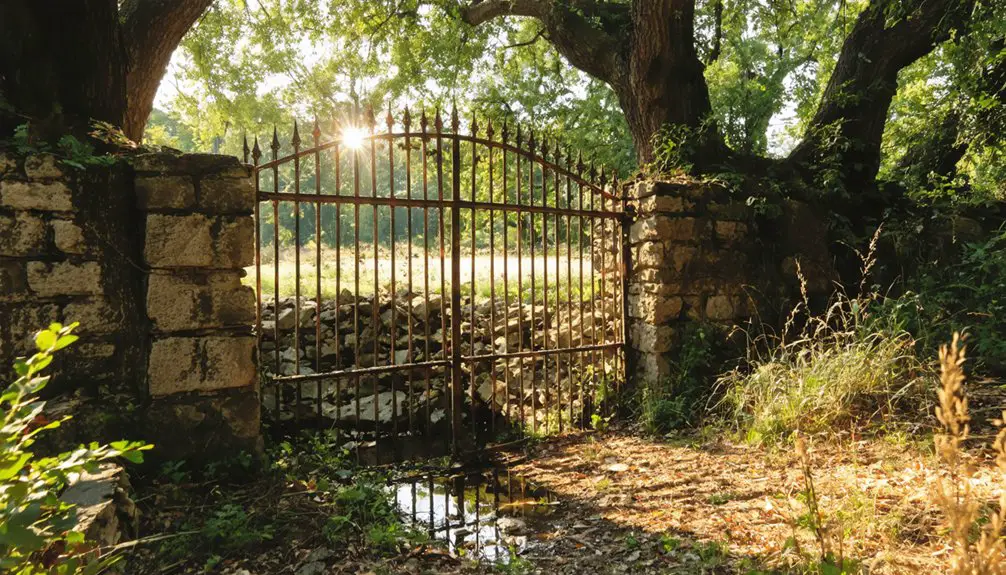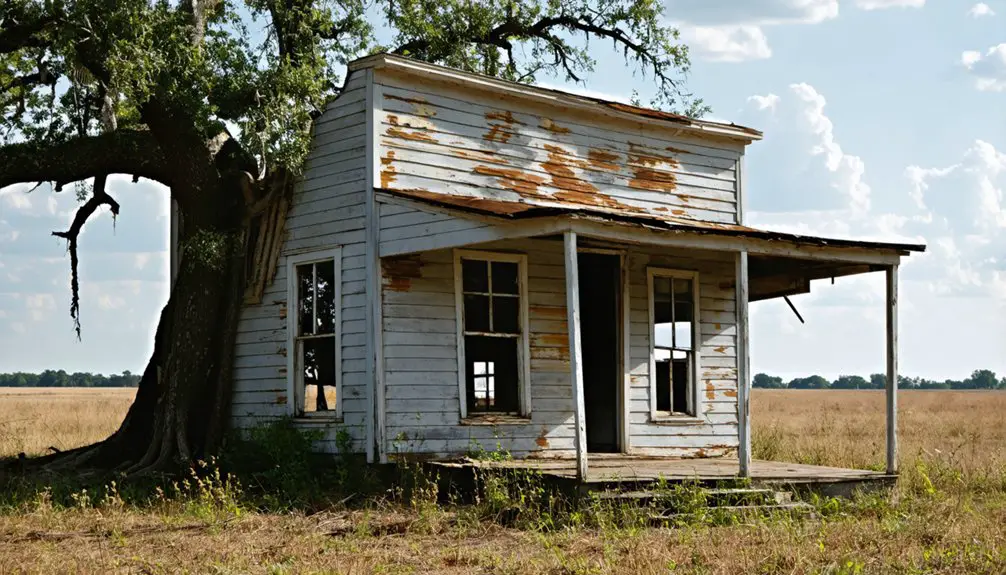You’ll find Dalby Springs tucked away in Northeast Texas, where Warren Dalby first settled in 1839. This former boomtown peaked in the 1920s with 500 residents who came for the healing mineral springs rich in sulfur and iron. The town boasted hotels, stores, and a Methodist church, but by 1950 the population had dwindled to just 50. Today, weathered headstones and rusty hand pumps tell silent stories of this once-thriving health destination’s remarkable past.
Key Takeaways
- Dalby Springs declined from a thriving population of 400-500 in the 1920s to just 50 residents by 1950.
- The town’s original prosperity centered around healing mineral springs containing sulfate, chloride, iron, and manganese.
- Most businesses, including general stores and the blacksmith shop, closed during the economic downturn after 1940.
- The historic Methodist Church, built in 1888, fell into disrepair and symbolizes the town’s transformation into a ghost town.
- Today, only weathered buildings, hand pumps, and a well-maintained cemetery remain as evidence of the former settlement.
The Warren Dalby Legacy: First Settlement in 1839
While many Texas pioneers sought their fortunes in the 1830s, Warren Dalby’s journey to east Texas in 1839 would leave an indelible mark on the region’s history.
You’ll find that the Dalby family, consisting of Warren, his wife Lucy, and their seven children, made their way to Bowie County by ox-drawn wagon, seizing an opportunity from the Republic of Texas’s offer of 640 acres to western settlers.
Warren didn’t waste time in securing his family’s future. He built a sturdy double log cabin from hand-hewn oak and completed his land acquisition through formal channels by 1842, receiving his patent certificate from the governor.
Even after Lucy’s death in 1845 left him raising their younger children alone, Warren remained on the property until his passing in 1889. Among his descendants was Norman Leonard Dalby, who would later become a prominent district judge in the region. The family’s discovery of red water springs before 1850 would eventually give the town its distinctive name.
Medicinal Springs and Early Town Development
Once the Dalby family settled in the area, they discovered a series of mineral springs that would transform their frontier settlement into a bustling health destination.
You’d find these healing waters rich in sulfate, chloride, iron, and manganese – perfect for the community health concerns of the time. By 1911, four distinct springs attracted settlers seeking nature’s cure, leading J.W. Farrier to establish a hotel resort.
If you’d visited in the late 1800s, you would’ve encountered:
- Red-tinted spring water with a distinctive sulfurous aroma
- A hand pump drawing mineral-rich water for enthusiastic health seekers
- A thriving town of 250 residents with five mills, five gins, and various stores
These springs didn’t just provide water – they built a community that flourished around their promise of healing. The Woodmen of the World members became prominent citizens, marking their legacy with distinctive tree-shaped tombstones in the local cemetery.
The area’s first settlement began in 1839, marking the start of this remarkable community’s history.
Peak Years of Growth and Commerce
During the roaring 1920s, Dalby Springs reached its golden age as a thriving commercial hub with a bustling population of 400 to 500 residents.
You’d have found four general stores stocked with essentials, two welcoming hotels, and a blacksmith ready to serve your needs. The town’s economic resilience shone through its diverse businesses – from a cotton gin processing local harvests to a grist mill grinding grain for self-sufficient farmers.
The community dynamics centered around family-run enterprises, with the Dalbys, Pirkeys, and Hughes leading the charge in commerce and land ownership. The area later became officially annexed by DeKalb in 1953. Today, visitors must traverse through the woods to explore what remains of this once-vibrant town.
You could’ve purchased bottled sulfur water from the local plant or gathered supplies at the dry goods stores. The Methodist Church served as the social backbone, weaving together commerce and community spirit until the town’s gradual decline began in the 1940s.
Methodist Church: A Community Cornerstone
You’ll find the old Methodist Church of Dalby Springs standing as the town’s longest-serving spiritual anchor, having provided a gathering place for worship since 1839 before its first permanent structure was built in 1888.
The church’s knotless pine walls witnessed generations of baptisms, marriages, and funerals, while its adjacent cemetery holds the stories of the town’s earliest settlers and their descendants. The cemetery serves as the final resting place for many of the area’s notable pioneer families, including the Pirkeys, Dalbys, and Hughes.
Though time hasn’t been kind to this sacred space, the building’s weathered frame and historical marker remind you of when it served as the beating heart of this once-thriving community. Similar to the early DeKalb Methodist Church, it served dual purposes as a log structure schoolhouse.
Historical Religious Significance
In 1839, when Northeast Texas was still a rugged frontier, the Methodist congregation of Dalby Springs first gathered in settlers’ homes to worship, laying the spiritual foundation for what would become a cornerstone of community life.
The Methodist heritage flourished, leading to the construction of a distinctive church building in 1888, crafted from knotless pine lumber. The area’s spiritual significance was enhanced by the Upper Natchitoches tribe who had inhabited the region long before European settlers arrived.
You’ll find this spiritual influence reflected in three enduring elements:
- Multiple generations of prominent local families serving as ministers
- A historic cemetery featuring wooden Woodmen of the World markers
- The church’s role as one of the last standing structures from Dalby Springs’ heyday
Even as the town declined, the Methodist church remained a symbol of the settlers’ unwavering faith and determination to maintain their religious identity in the wilderness.
Deteriorating Sacred Space
Time has taken its toll on the once-proud Dalby Springs Methodist Church. Since its 1888 construction using knotless pine lumber, you’ll find this sacred space battling East Texas’s unforgiving climate. The wooden beams sag, the roof deteriorates, and the foundation threatens collapse – all stark reminders of nature’s relentless march.
You’re witnessing more than just physical decay here. As the church’s walls crumble, so does its role in sacred symbolism and community cohesion. The structure stands as a testament to the town’s golden era when 250 residents called Dalby Springs home in the mid-1880s.
Where Methodist congregants once gathered in fellowship, you’ll now see a structure that’s losing its fight against time. Without funding or an active congregation to champion its preservation, this historic landmark faces mounting challenges from vandalism, weather damage, and structural instability, making it increasingly difficult to maintain its connection to Dalby Springs’ spiritual heritage.
Community’s Lost Cornerstone
Since its humble beginnings in 1839 with worship services held in local homes, the Dalby Springs Methodist Church evolved into the community’s beating heart.
As you trace the spiritual legacy through generations of ministers and congregants, you’ll find the church stood resilient amid changing times, preserving community heritage even as the town’s population dwindled after 1940.
Within these pine-hewn walls, your ancestors:
- Gathered not just for worship, but to strengthen bonds with neighbors and maintain social ties
- Safeguarded essential cemetery records and family histories until fire claimed these precious documents
- Built lasting traditions that anchored local identity for over 125 years
You can still sense the church’s significance as one of the few structures that outlasted Dalby Springs’ decline, standing proof of the town’s enduring faith.
Life in Northeast Texas Farm Country
Life on Northeast Texas farms revolved around a diverse agricultural landscape where cotton reigned supreme, though savvy farmers knew better than to put all their eggs in one basket.
You’d find folks growing everything from corn and soybeans to pecans, while running cattle and harvesting timber in the Piney Woods. These agricultural practices shaped the region’s character, with families working their own land and building tight-knit communities around small towns.
You couldn’t miss the cowboys and their longhorns, driving cattle across open ranges and making history on those legendary trails to distant markets.
Rural traditions ran deep, from leather working to woodcraft, and you’d spot ranch hands living modest lives while tending to the daily demands of farm life.
Local markets buzzed with homegrown goods and handcrafted items, keeping the spirit of independence alive.
The Gradual Decline After 1940

When the 1940s rolled around, Dalby Springs began its slow fade into ghost town territory, with its population dwindling to just 50 residents by 1950.
The once-bustling community succumbed to economic stagnation as businesses shuttered their doors and the mineral springs, which had drawn visitors for generations, slowed to a trickle.
Population isolation became the new reality as you’d find:
- Four general stores, the blacksmith shop, and cotton gin all closed down
- The Methodist church fell into disrepair, its bell silenced after decades of calling folks to worship
- Only the cemetery remained well-maintained, though its weathered headstones told tales of better days
The town’s decline mirrored many rural Texas communities of the era, leaving behind empty buildings and quiet streets where commerce once thrived.
Historic Cemetery and Local Legends
As you stroll through the historic Dalby Springs Cemetery, you’ll find yourself walking among markers that tell tales dating back to 1847, when Mary Ellen Maglin Proctor Sampson became the first soul laid to rest on these grounds.
You’ll notice weathered headstones bearing witness to generations of local families, including the Dalbys, who first buried Nancy Ann Bullock Dalby here in 1848.
Local cemetery folklore speaks of a mysterious iron-fenced grave that’s said to contain a vampire, complete with tales of an iron stake found within.
Among the weathered stones lies an iron-fenced plot, where whispered tales tell of a vampire’s grave marked by a rusted stake.
While preservation efforts try to maintain the grounds, you’ll see the toll that time has taken on the aging markers.
Despite incomplete records and vandalism over the years, this sacred space remains a powerful connection to the past for descendants whose relatives span centuries of burials.
Surviving Landmarks and Structures

You’ll find the old Methodist Church still standing after 125 years, though its deteriorating floors, missing pews, and damaged ceilings tell the story of time’s relentless march.
The church’s rusted bell, once used to call townspeople to worship, now sits silently beside the weather-worn structure that anchored community life for generations.
Next to the church, the historic cemetery continues on, its headstones bearing silent witness to Dalby Springs’ past, though many markers now face their own battle against erosion and decay.
Methodist Church Remains
Built in 1888 from pristine knotless pine lumber, the Dalby Springs Methodist Church stands as one of the most significant surviving structures in this ghost town.
You’ll find this iconic example of rural Texas church architecture next to a historic cemetery that dates back to the 1840s, where both white and African American congregation members rest. The church served as the heart of community gatherings for decades until the town’s decline around 1940.
When you visit today, you’ll discover:
- Original iron fencing marking the sacred grounds
- Fire-damaged sections that claimed many church records
- Weathered headstones that tell stories the lost documents can’t
The site remains a powerful reflection of the spiritual heritage of early Texas settlers, though time and elements continue to take their toll.
Cemetery Through Time
Since 1847, the Dalby Springs Cemetery has chronicled the town’s history through its weathered headstones and time-worn grounds.
You’ll find Mary Ellen Maglin Proctor Sampson’s grave marking the cemetery’s earliest burial, followed by Nancy Ann Bullock Dalby’s interment in 1848.
While cemetery preservation remains an ongoing challenge, with fungus-eaten stones and vandalism taking their toll, local families still maintain the grounds.
Though a church fire destroyed original records, the surviving headstones serve as essential historical markers of the area’s pioneer families.
You might’ve heard tales of the infamous “vampire grave” with its iron fence – it’s just local folklore, but it’s added a mysterious charm that draws curious visitors.
Despite Dalby Springs’ ghost town status, this cemetery continues to connect descendants with their roots.
Modern Rural Life and Community Identity
While Dalby Springs may seem quiet today, its aging population of 1,689 tells a complex story of rural transformation in modern Texas.
You’ll find a resilient community holding onto its cultural heritage despite economic challenges, with a median household income of $36,654 – less than half the state average.
Modern life in Dalby Springs reflects broader rural trends, where you’ll discover:
Dalby Springs mirrors the story of rural America, where small towns adapt and persevere despite mounting modern challenges.
- Longstanding churches and schools serving as anchors of community identity
- A tight-knit population with 20% aged 65 or older, preserving local traditions
- Residents adapting to limited services while maintaining strong social networks
Despite fewer rated businesses and lower internet connectivity than urban areas, the community’s spirit endures through shared memories of its medicinal springs and settlement history, even as younger generations seek opportunities elsewhere.
The Springs Today: From Medicine to Memory

If you visit Dalby Springs today, you’ll find the once-bustling sulfur springs reduced to a mere trickle, with hand pumps now extracting what remains of the historic red-tinted water.
These modest pumps stand as quiet reminders of an era when locals bottled and sold the mineral-rich water for its purported healing properties.
While the springs no longer fuel a thriving health tourism industry, they continue to serve the scattered local residents who still believe in the water’s medicinal benefits.
Current Spring Water Status
Though Dalby Springs once flowed freely as a treasured medicinal water source, today’s measurements tell a different story through the Sulphur River‘s fluctuating streamflow.
You’ll find recent gauge heights between 4.55 and 6.56 feet, with flows around 21 cfs – a far cry from the healing waters that once drew visitors from miles around. Modern water management practices have transformed the springs from their natural state.
- Hand pumps have replaced the bubbling springs of yesteryear
- River gauges now track water levels where medicine-seekers once gathered
- The Sulphur River’s seasonal peaks and valleys dictate water availability
While spring flow remains above historical minimums at 139.7% of normal, you’re witnessing the change from nature’s pharmacy to a carefully monitored water resource.
Hand Pumps Replace Flow
Today’s Dalby Springs bears little resemblance to its bubbling medicinal heyday, with hand pumps now standing sentinel where sulfur water once flowed freely from the ground.
You’ll find these simple mechanical devices, reminiscent of 1840s pitcher pumps, dotting the landscape near what was once the community’s bustling center.
If you’re curious enough to work these iron relics, you’ll need some muscle – the dark, tea-colored sulfur water doesn’t come easy anymore.
The pumps, with their leather gaskets and straps, still function when used regularly, but they’re more historical markers than practical water sources now.
It’s a far cry from the days when locals bottled and sold this mineral-rich water.
Like silent witnesses to changing times, these hand pumps tell the story of a once-thriving spring town’s transformation.
Medicinal Legacy Lives On
While the medicinal springs that once drew thousands no longer flow freely, their legacy endures in the sulfurous water you’ll find trickling from the remaining hand pumps.
During the height of medicinal tourism in the late 1800s, visitors flocked to these springs seeking mineral healing for various ailments, turning this quiet Texas town into a bustling health resort.
You can still experience echoes of that era today:
- Dark, tea-colored water emerges from hand pumps, carrying the same distinct sulfurous aroma that attracted health-seekers.
- High levels of sulfate, chloride, iron, and manganese remain in the water, just as they did in the spring’s heyday.
- Historical markers tell the story of countless visitors who journeyed here seeking nature’s cure.
Frequently Asked Questions
What Native American Tribes Originally Inhabited the Dalby Springs Area?
You’ll find the Caddo people were the area’s primary cultural heritage, establishing deep tribal history there before Comanche and Apache groups later moved through during the pre-colonial and early settlement periods.
Did Any Famous Outlaws or Historical Figures Ever Visit Dalby Springs?
Like a well-worn trail gone cold, you won’t find any confirmed outlaw sightings or visits from famous historical figures here. Local folklore exists, but there’s no documented historical significance of notorious visitors.
What Were the Average Property Values During the Town’s Peak Years?
You’ll find property trends ranged from $10-100 per acre for rural land, while prime commercial spots near the springs fetched higher prices, driven by economic factors during the 1900-1920 boom.
Were There Any Documented Supernatural Occurrences Besides the Vampire Graveyard Legend?
You won’t find any verified supernatural sightings or ghostly encounters beyond the vampire graveyard story. Local records and resident accounts don’t support other paranormal claims despite the town’s ghostly reputation.
How Many Students Attended the Local School Before It Closed?
You won’t find exact student enrollment numbers in the school’s history, but given the town’s population of 250 in 1888 and its one-teacher setup by 1927, there were likely dozens to under 100 students.
References
- https://kkyr.com/dalby-springs-cemetery/
- https://kkyr.com/dalby-springs-residents/
- https://www.youtube.com/watch?v=UbeRR4NlFtI
- https://1dustytrack.blogspot.com/2012/01/dalby-springs-texas-ghost-town.html
- https://www.ghosttowns.com/states/tx/dablysprings.html
- https://www.tshaonline.org/handbook/entries/dalby-springs
- https://www.texasescapes.com/EastTexasTowns/Dalby-Springs-Texas.htm
- https://www.tshaonline.org/handbook/entries/dalby-springs-tx
- https://kkyr.com/origin-of-dalby-springs/
- https://homepages.rootsweb.com/~lpproots/tx-dalby/dalbyhistory.htm



